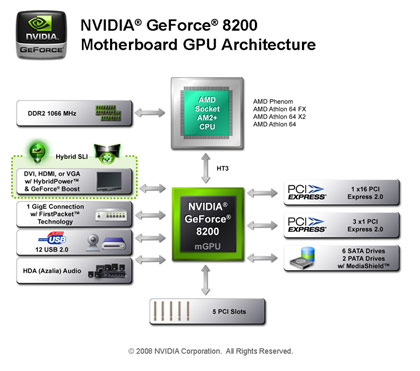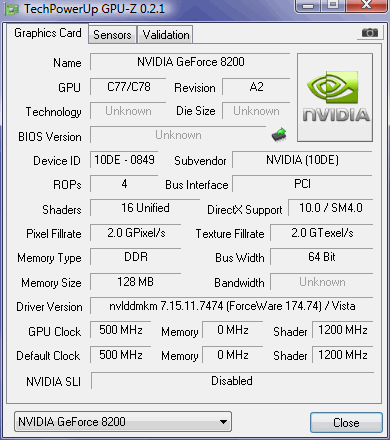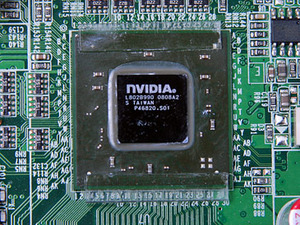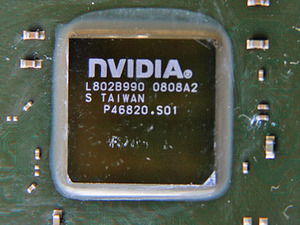Jetway JNC62K (GeForce 8200)
Manufacturer: JetwayUK Price (as reviewed): £88.13 (inc. VAT)
US Price (as reviewed): $146.25 (ex. Tax)
Introducing Nvidia’s GeForce 8200 Chipset
Nvidia has announced a lot of new products in the last few months, but it’s taken some longer than expected to make it out of the door. The one we’ve been looking forward to the most, and the one that we were promised before CeBIT, has been constantly eluding our grasp. Nvidia’s GeForce 8200 mGPU (or IGP) is that chipset and its potential got us excited when it was first announced by the company at CES.However, since then AMD has announced—and shipped—its 780G chipset. We’ve had such a great experience with AMD’s HD video accelerating behemoth and, what’s more, it’s been without competition ever since it launched. I guess you could say finally there’s some competition for it and that comes in the form of Nvidia’s GeForce 8200 IGP, the company’s first DirectX 10 mGPU.
It’s fair to say that Nvidia’s GeForce 7-series IGPs left us a little underwhelmed: only the 7050PV had the PureVideo engine and Nvidia never dropped the same video decoding features into the 7100 and 7150 IGPs which used the more popular Intel CPUs. That’s not to say AMD doesn’t make some excellent, inexpensive and very low power CPUs though – these are perfectly suited to a home theatre PC and thankfully the GeForce 8200 has an upgraded PureVideo engine that now natively accelerates HD movies encoded in h.264, VC-1 and MPEG-2.
 Like the standard S/PDIF pass through on the 780G's UVD engine, the Nvidia GeForce 8200 PureVideo HD engine is also limited to an S/PDIF pass through – this means you'll not get Dolby TrueHD and DTS-HD Master Audio streams via HDMI. While some boards may claim HDMI 1.3a support, Windows doesn't offer the facility to use higher bitrates than 24-bit (RGB), meaning Deep Colour is off the menu as well, meaning that a true HD enthusiast will still have to look to CE devices for a complete solution.
Like the standard S/PDIF pass through on the 780G's UVD engine, the Nvidia GeForce 8200 PureVideo HD engine is also limited to an S/PDIF pass through – this means you'll not get Dolby TrueHD and DTS-HD Master Audio streams via HDMI. While some boards may claim HDMI 1.3a support, Windows doesn't offer the facility to use higher bitrates than 24-bit (RGB), meaning Deep Colour is off the menu as well, meaning that a true HD enthusiast will still have to look to CE devices for a complete solution.Along with the nForce 780a and 750a chipsets, for the first time Nvidia also includes its Hybrid SLI technology too under the brand name GeForce Boost.
If you install a GeForce 8400 GS or 8500 GT, the IGP and GPU will work together to increase the framerate. It won’t great a gaming powerhouse but it will throw in a bit more performance for very little money. The AMD 780G chipset directly competes against this with its Hybrid CrossFire technology.
What AMD doesn’t offer on its 780G chipset is an equivalent to HybridPower technology – something that the GeForce 8200 mGPU does offer over its major competitor. This is where a high end GeForce 9-series GPU can be used in conjunction with the IGP to save power when the discrete GPU’s power isn’t required. In a normal desktop environment, where the end user is surfing the ‘net or doing simple things that don’t require much GPU performance the low power IGP can be used while the power-hungry discrete GPU is switched off.
Then when a game is started or the GPU is needed for (future) CUDA applications, then the more powerful discrete GPU can be used instead. While the first version of this technology has some serious limitations—only one digital display that’s limited to a single link DVI connection (meaning resolutions no higher than 1,920 x 1,200) and having to manually switch between IGP and GPU—HybridPower can provide some serious power savings.
 There are more differences than just HybridPower though; first, the GeForce 8200 IGP is a single chip solution which means its overall footprint is smaller and it’s therefore easier to implement onto smaller form factor motherboards – this is perfectly demonstrated with by Jetway’s mini-ITX JCN62K, the board we’re looking at here today. The manufacturing process is 65nm, compared to the 55nm process used for 780G and SB700, however both can be passively cooled as the GeForce 8200 uses very little power, just like the 780G chipset.
There are more differences than just HybridPower though; first, the GeForce 8200 IGP is a single chip solution which means its overall footprint is smaller and it’s therefore easier to implement onto smaller form factor motherboards – this is perfectly demonstrated with by Jetway’s mini-ITX JCN62K, the board we’re looking at here today. The manufacturing process is 65nm, compared to the 55nm process used for 780G and SB700, however both can be passively cooled as the GeForce 8200 uses very little power, just like the 780G chipset. One thing that’s always been completely polar about Nvidia chipsets is that the high-end chipsets are consistently being produced on older technology – for example, the MCP570 south bridge featured on the nForce 590, 680i, 780i and 790i is still made using the 130nm process, while the north bridges were being made on 90nm. These nForce boards are legendary for running super hot so need a few kilos of metal to keep things relatively cool. In comparison, the Nvidia GeForce 8200 IGP is made on a far more recent manufacturing process, meaning it runs much cooler and the heat is easier to deal with.
The GeForce 8200 chipset supports AM2+ CPUs that feature an updated HyperTransport 3.0. This also means that DDR2 support is up to 1,066MHz and the chipset can handle both Athlon and Phenom CPUs. However, following our experiences with several AMD 790X and 780G motherboards, which CPUs it can handle will depend motherboards’ PWMs.
For such a small chipset, the GeForce 8200 really is kitted out with all the latest goodies: there is a single PCI-Express x16 slot for graphics and three PCI-Express x1 slots for other peripherals – all of which have been upgraded to PCI-Express 2.0. In addition there are lots of USB 2.0 ports, plenty of SATA 3Gbps sockets and even an IDE channel still natively included. All the hard drive connectivity is still covered by the Media Shield and a RAID 0, 1, 0+1, 5 or JBOD array can be spread across all these sockets. Finally there’s also a High-Definition audio connection and a PHY Gigabit Ethernet connection with Nvidia’s FirstPacket technology included, negating the need to use up a PCI-Express x1 lane.

MSI MPG Velox 100R Chassis Review
October 14 2021 | 15:04











Want to comment? Please log in.